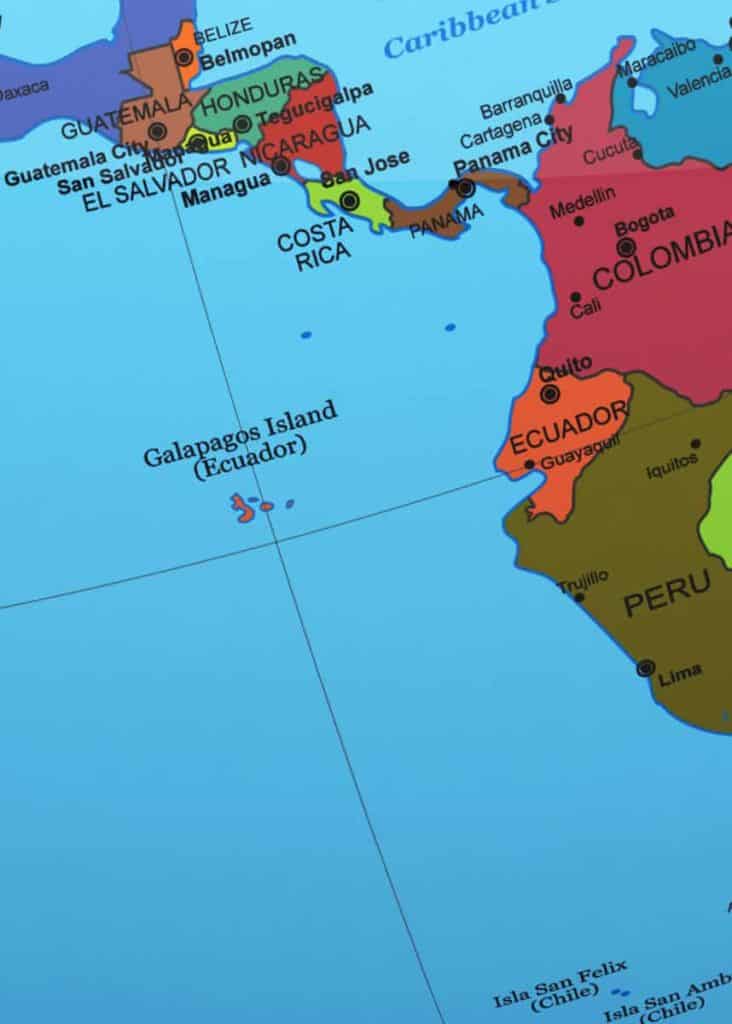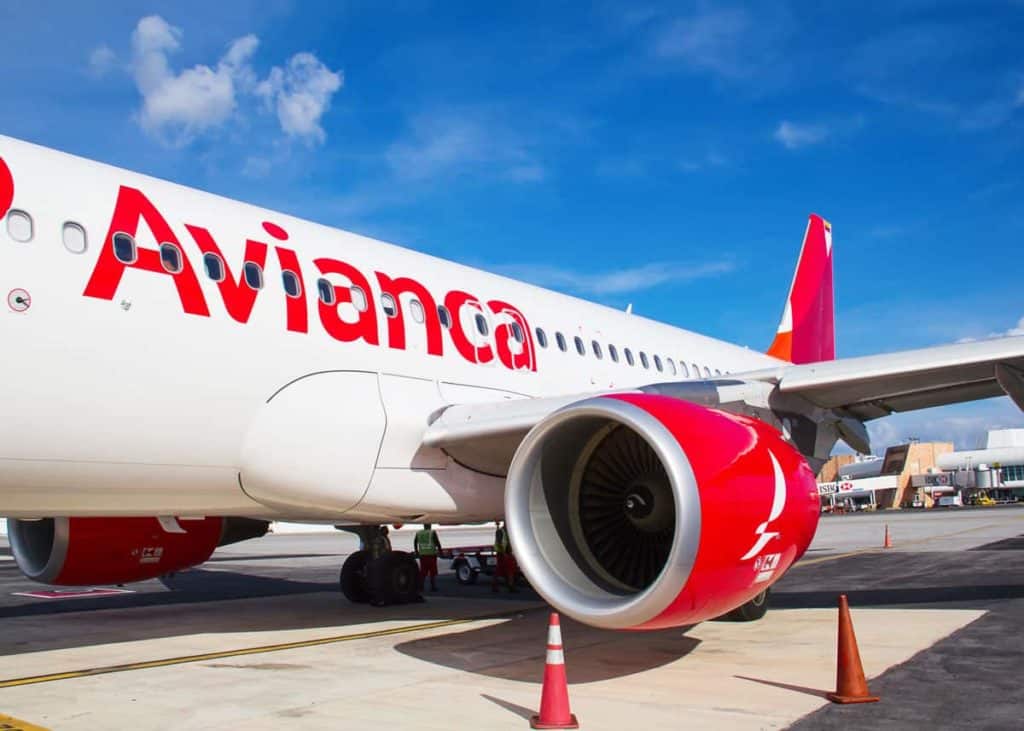Where are the Galapagos Islands Located? Coordinates, Elevation, Timezone…
The Galapagos Islands are a top destination for nature lovers all over the globe. But where are the Galapagos Islands located? Which country do they belong to and how do you get there? We’ll cover this and more in this post, so let’s get started.

Where are the Galapagos Islands?
The Galapagos Islands are located in South America, off the coast of Ecuador. They are a group of islands and islets situated along the Equator in the Tropical Eastern Pacific Ocean.
They are easily located on a map because they are the closest clearly visible cluster of islands to the west (left) of mainland Ecuador. You can see them just off the coast on the following map.
Some of the islands are found in the northern hemisphere, and others in the southern hemisphere. Isabela (the largest island) is located directly on the equator.
What Country do the Galapagos Islands Belong to?
The Galapagos Islands belong to Ecuador. The Islands were annexed by Ecuador in 1832.

What are the Coordinates of the Galapagos Islands?
It’s a little difficult to give an exact location of the Galapagos because they are an archipelago of islands. So each island has its own coordinates.
Here are the latitude and longitude for the Galapagos Islands:
- Latitude -0.457212 (DMS lat 0° 27′ 25.96″ S)
- Longitude -90.274332 (DMS long 90° 16′ 27.59″ W)
I’ve chosen the coordinates for the Galapagos based on Baltra Island because that’s where the busiest airport is and where most visitors land when traveling to the islands.
Opinions vary on the specific number of islands that comprise the Galapagos but it’s commonly accepted that there are 20 islands, 13 of which are main islands and 7 smaller islands.
What is the Elevation of the Galapagos?
The highest elevation in the Galapagos is Volcan Wolf at 5,600 ft (1,707 m). Volcan Wolf is found on Isabela Island.

Learn more about Galapagos volcanoes.
What Timezone are the Galapagos in?
You might assume (as I did) that the Galapagos Islands are in the same time zone as Ecuador, but they’re not.
The islands are one hour behind the mainland. So as you travel from the mainland to Galapagos you’ll need to set your watch back an hour.
Here are the time zones for Galapagos and mainland Ecuador:
- Galapagos Islands time zone: UTC/GMT -6
- Mainland Ecuador time zone: UTC/GMT -5.
On the islands, you’ll be on Galapagos Island Time – abbreviated as GALT.

Galapagos Islands Location: Geological Significance
This is one of the things that makes the Galapagos such a special place.
The Galapagos are volcanic islands believed to have been created by the Galapagos hotspot.
The hotspot is located near the spreading ridge between two of the tectonic plates (Nazca and Cocos) which make up part of the Galapagos Triple Junction.
The Galapagos Triple Junction is where the Nazca, Pacific and Cocos Plates (three tectonic plates) meet. There are also two small microplates that get jammed up in this junction, the Northern Galapagos Microplate and the Galapagos Microplate. The Galapagos Islands are located on (above) this junction.
What does all of this mean?
Volcanic activity – which has resulted in a very interesting landscape both above and below the water. Volcanoes to hike, volcanic tubes (tunnels) to explore, and interesting channels/gullies to dive and snorkel around.
Because (as the hotspot theory explains) the tectonic plates are moving (very, very slowly) away from the Galapagos hotspot the islands also look very different.
Some of them are lush and others are barren. Some have active volcanoes and others have dormant or extinct volcanoes.

Oceanic Location of the Galapagos: 3 Converging Currents
Have you ever wondered what makes the Galapagos one of the best dive/snorkel sight in the world? The answer is found in the 5 ocean currents that influence the waters around the islands.
The 3 that have the most impact are the:
- Panama Current: warm water
- Cromwell Current: cold nutrient-rich water
- Humboldt Current: cold nutrient-rich water
As these swirl around the islands (some bringing surface water, others deep upswells) they constantly change the nutrients available to oceanic life in the Galapagos.
The Cromwell and Humboldt currents are perhaps the most important because they bring in cold nutrient-rich water. This is what supports the abundant marine life of the Galapagos.
They also affect the temperature of the water making life possible for animals like the Galapagos penguin.
The following video by NASA shows surface currents as they flow around the globe. I’ve set it to start just as the Galapagos Islands become visible.
Unfortunately, you can’t see the upwelling currents (like the Cromwell) as they affect the islands, but it gives a pretty clear picture of the unique oceanic location of the Galapagos.
How far from Mainland Ecuador are the Galapagos?
When looking at a map the Galapagos Islands don’t look like they are very far from Ecuador’s mainland. But looks can be deceiving.
The Galapagos are located 926 km (575 mi) out into the Pacific.
How Long to Get to the Galapagos?
Because of the distance, the most common way to get there is by plane. But you can only fly to the Galapagos from mainland Ecuador. The islands don’t receive international flights.
So you will need to book a flight to Ecuador, and then fly to the islands from either Quito or Guayaquil.
If you’re flying from Quito (in the Andes Mountains) you’ll most likely stop in Guayaquil (on the coast) first. So although your overall trip will be longer your flight from the mainland to the islands is the same.
So no matter where you live you’ll probably be flying from Guayaquil to the islands, which means your flight to the Galapagos will take around two hours (give or take a little).
When you arrive, you will either land at the airport on Baltra or San Cristobal island.

Not sure if it’s worth traveling to the Galapagos? Here are 4 reasons to visit the Galapagos Islands.
Where are the Airports in the Galapagos?
There are two major airports in the Galapagos:
- Seymour Airport on Baltra Island
- San Cristobal Airport on San Cristobal Island
Seymour Airport is the busiest in the Galapagos and the world’s first green airport. You may hear it called Santa Cruz airport because that’s the island most visitors travel to first after landing on Baltra, but there is no airport on Santa Cruz Island.
Your tour package will most likely be the determining factor as to which airport you’ll use.
But if you’re making travel plans yourself and you really hate boat travel than you may want to think about planning your trip through San Cristobal airport. San Cristobal is the second most populated island in the Galapagos and you can find lots to do there.
If you travel through Seymour Airport on Baltra Island you’ll need to take a short boat ride to Santa Cruz Island (the most populated island) unless you are boarding your Galapagos cruise from there. Baltra Island is basically just a landing point for tourists.
We really enjoyed the boat ride to Santa Cruz, it was beautiful and we saw our first glimpses of Galapagos wildlife there, including the blue-footed booby. But if you’re really against boats than San Cristobal may be a better choice.
Learn more about Galapagos airports in this popular post. And here are the best Galapagos beaches to visit.
And don’t forget about getting some good waterproof bags for your Galapagos adventures.

Learn more with these 25 Galapagos Islands Facts.
Will You Find Your Way There?
Now that you know where the Galapagos are located, do you think you’ll ever go?
It’s an adventure we will never forget; we still talk about swimming with sea lions and sea turtles, hiking up volcanoes, and seeing how big those giant tortoises really are.
I hope you make your way there someday.
If you like, you can take a little trip now with Google Maps as they map out the Galapagos. In the following video, you’ll see the location of some of the islands and catch a glimpse of some amazing wildlife.
If you have any questions or would like to add to this post please join me in the comments.
Want to learn about more national parks in Ecuador? Check out this post, where you can read about all 11 of them.







